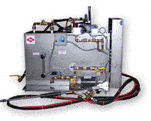Why is Phosphating Important?
Leave a CommentPhosphating, also called phosphatizing, or phosphate conversion coating, is the process of applying a phosphate solution, such as iron, zinc, or manganese phosphate, to a metal surface by spraying or immersion. This forms a chemically bonded layer of phosphate crystals on the surface of the material.
It is used for applications in which corrosion protection, wear reduction, improved paint and coating adhesion, and electrical insulation are necessary. Phosphating is most commonly used with carbon steel, low-alloy steel, and cast iron; although, non-ferrous materials may also be coated with this process.
Phosphate treatment uses steam for pre-cleaning the metal substrate and for applying phosphorus solution for proper adhesion. Electro-Steam Generator Corporation’s electric steam generators are specifically designed for steam pretreatment cleaning and phosphorous application.

Phosphate treatment is used in many industries to support efficient manufacturing, equipment durability, and more.
Corrosion Protection
Phosphating provides a layer of corrosion resistance to metal substrates. The phosphate crystals created in the process make the substrate electrically non-conductive, impeding electron transfer, and thereby reducing oxidation (i.e., rust).
Phosphate crystals can also provide a barrier between cathodic and anodic parts, protecting components from filiform or underfilm corrosion.
Wear Reduction
Phosphate coatings protect metal surfaces from wear and tear over time. As the grain size of the phosphate crystals increases, wear resistance improves. The coating also prevents galling and aids in absorbing lubricants, which reduce friction and improve wear in moving parts in manufacturing and other settings.
Phosphate coatings can also provide a uniform surface after lapping or machining, reducing the appearance of surface irregularities, preventing cold welding of metal parts, and improving the efficiency of lubricants.
Adhesion Promotion
Phosphate coatings are an important step in surface preparation for coatings such as paint, powder coatings, polymer films, epoxies, oils, or waxes. The phosphate crystals on the surface of the metal give subsequent coatings an improved surface area and micro-roughness that result in more durable paint and coatings.
Electrical Insulation
Phosphate coatings are electrically non-conductive; therefore, even very thin layers are effective at reducing the conductivity of the underlying material. This makes it an effective choice for preventing corrosion or in other applications where insulation is critical, such as in motor or electrical components.
Explore Electro-Steam Generators for Phosphating
Electro-Steam is an industry leader with over 70 years of experience in electric steam generator manufacturing and service. We use the highest quality parts in all of our equipment and offer a five-year warranty on chambers and a one-year warranty on other components.
Our knowledgeable staff is ready to assist you in selecting the right electric steam generator for your needs. Please contact us to learn more about our generators’ cleaning and phosphating applications.
 Proudly Manufactured in the USA
Proudly Manufactured in the USA 